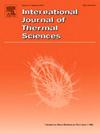Experimental study on heat transfer deterioration and critical heat flux of DNB type in helically coiled tubes
IF 4.9
2区 工程技术
Q1 ENGINEERING, MECHANICAL
International Journal of Thermal Sciences
Pub Date : 2025-04-25
DOI:10.1016/j.ijthermalsci.2025.109956
引用次数: 0
Abstract
Helically coiled tubes (HCTs) are extensively utilized in numerous engineering fields due to their exceptional heat transfer and structural capabilities. The thermal safety within HCTs is crucial for the long-term stable operation of heat transfer systems. The heat transfer deterioration and critical heat flux (CHF) of departure from nucleate boiling (DNB) type in the HCTs at subcritical pressure were experimentally studied in this paper. The special circumferential wall temperature distribution was obtained and the effects of inlet cooling, pressure, mass velocity and HCT orientation on CHF were investigated. As the inlet subcooling increased, the CHF increased almost linearly. As the mass velocity increased, the turbulence degree in the HCT increases significantly, bubbles were less likely to merge and accumulate, and the CHF increased substantially. It was found that the CHF in the vertical HCT was higher than that in the horizontal HCT under the same working conditions because of the combined action of gravity and centrifugal force. The CHFv/CHFh exhibits a reduction with elevated inlet subcooling and pressure, and the influence of mass velocity on CHFv/CHFh is related to the pressure. New orientation-specific CHF correlations for vertical and horizontal HCTs are developed, achieving high prediction accuracy across pressures of 16–20 MPa and mass fluxes of 320–560 kg m−2 s−1. These findings can provide theoretical support for the optimization design and safe operation of the HCT heat transfer systems.
DNB型螺旋盘管传热劣化及临界热流密度的实验研究
螺旋盘管(hct)由于其特殊的传热和结构性能,在许多工程领域得到了广泛的应用。高温混凝土内部的热安全对传热系统的长期稳定运行至关重要。实验研究了亚临界压力下hct的传热劣化和非核沸腾(DNB)型临界热流密度。得到了特殊的周向壁面温度分布,并研究了进口冷却、压力、质量速度和HCT方向对CHF的影响。随着进口过冷度的增加,CHF几乎呈线性增加。随着质量速度的增大,HCT内湍流度显著增大,气泡合并积累的可能性减小,CHF大幅增大。研究发现,在相同工况下,由于重力和离心力的共同作用,垂直高压连续油管的CHF高于水平高压连续油管。CHFv/CHFh随进口过冷度和压力的升高而降低,质量速度对CHFv/CHFh的影响与压力有关。开发了垂直和水平hct的新的定向CHF相关性,在16-20 MPa的压力和320-560 kg m - 2 s - 1的质量通量范围内实现了很高的预测精度。研究结果可为高压ct换热系统的优化设计和安全运行提供理论支持。
本文章由计算机程序翻译,如有差异,请以英文原文为准。
求助全文
约1分钟内获得全文
求助全文
来源期刊

International Journal of Thermal Sciences
工程技术-工程:机械
CiteScore
8.10
自引率
11.10%
发文量
531
审稿时长
55 days
期刊介绍:
The International Journal of Thermal Sciences is a journal devoted to the publication of fundamental studies on the physics of transfer processes in general, with an emphasis on thermal aspects and also applied research on various processes, energy systems and the environment. Articles are published in English and French, and are subject to peer review.
The fundamental subjects considered within the scope of the journal are:
* Heat and relevant mass transfer at all scales (nano, micro and macro) and in all types of material (heterogeneous, composites, biological,...) and fluid flow
* Forced, natural or mixed convection in reactive or non-reactive media
* Single or multi–phase fluid flow with or without phase change
* Near–and far–field radiative heat transfer
* Combined modes of heat transfer in complex systems (for example, plasmas, biological, geological,...)
* Multiscale modelling
The applied research topics include:
* Heat exchangers, heat pipes, cooling processes
* Transport phenomena taking place in industrial processes (chemical, food and agricultural, metallurgical, space and aeronautical, automobile industries)
* Nano–and micro–technology for energy, space, biosystems and devices
* Heat transport analysis in advanced systems
* Impact of energy–related processes on environment, and emerging energy systems
The study of thermophysical properties of materials and fluids, thermal measurement techniques, inverse methods, and the developments of experimental methods are within the scope of the International Journal of Thermal Sciences which also covers the modelling, and numerical methods applied to thermal transfer.
 求助内容:
求助内容: 应助结果提醒方式:
应助结果提醒方式:


